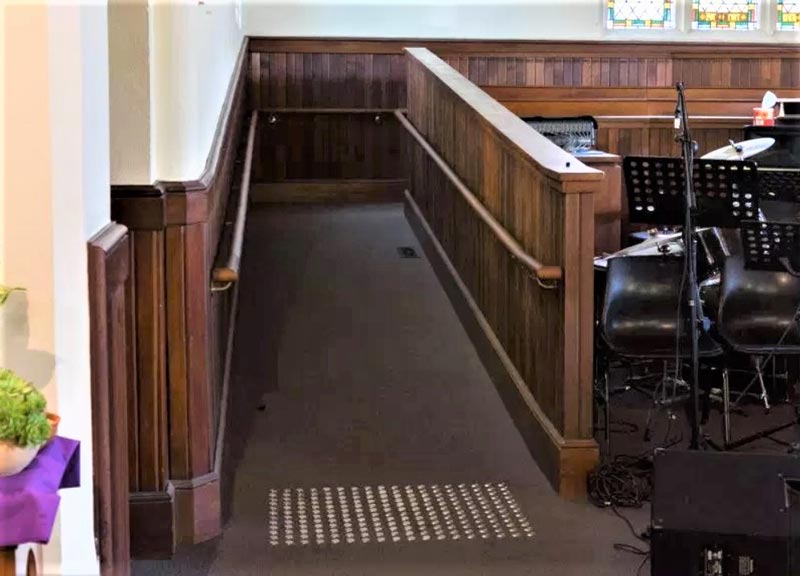Guidance Note 8 – Accessibility and Church Buildings
Accessibility is not just about wheelchairs. Many people with mobility issues are ambulant disabled – they walk, but with the aid of sticks or frames. Those with hearing or visual impairments should also be given consideration.
Under the Commonwealth Disability Discrimination Act (DDA) churches must comply with the Disability (Access to Premises—Building) Standards. The purpose of the Premises Standards is to:
- ensure that dignified, equitable, cost-effective and reasonably achievable access to buildings, and facilities and services within buildings, is provided for people with disability, and
- give certainty to building certifiers, developers and managers that if the Standards are complied with they cannot be subject to a successful complaint under the Disability Discrimination Act in relation to those maters covered by the Premises Standards.

Existing church buildings
When no construction work is being carried out to an existing church building there is no need to upgrade the building to comply with disability access requirements under NCC standards.
Alterations to an existing church building, though, may need a building permit to comply with the National Construction Code disability access provisions. If your church building is undergoing alterations a building certifier, architect, local council and/ or church head office should be able to advise on whether there is a need to comply with disability access requirements under current building codes and standards.

Below: Close up of tactile indicators similar to those in the photograph above. These are a building code requirement to help the visually impaired.

Codes, standards and guidelines
The Australian Building Codes Board publish a handbook online entitled Upgrading Existing Buildings (Handbook-Upgrading-Existing-Buildings.pdf ) that provides guidance for stakeholders of buildings in the interpretation of the standards and building codes with regard to disabled access.
The Building Code of Australia (BCA) sets out the minimum requirements for building design and construction throughout Australia. It references various Australian Standards and Codes to provide technical building requirements. Standards referenced by the BCA have legal application.
Australian Standards
There are several Australian Standards relevant to providing access to buildings and facilities. The most relevant one is AS 1428.1-2009 Design for access and mobility Part1: General requirements for access – New building work. There are two additional, more detailed parts to the standard.

Access consultants
Corrugated sheet metal roof finishes became common in South Australia only after the 1850’s when corrugated iron started to be manufactured in large quantities in the UK. Metal roofs provided a cheap and easy alternative to slate but the material only lasted 40 to 50 years. It was widely used because it was cheap, could span wide distances without requiring the supports needed for slates and tiles, and did not require to be fixed by specialist tradesmen, part of the reason why slating skills have been largely lost in South Australia.
Considerations for making your church building accessible
- Car parking spots close to the building entrance
- Walking paths that are as flat as possible and free of trip hazards
- Installation of ramps where there are steps
- Disabled toilets
- Door widths that allow for wheelchairs
- Visual aids such as tactile indicators near stairways
- Induction loop system for hard of hearing
- Large print hymnbooks and notices
- Easy-to-read directional signage
- Wheelchair spaces in main seating areas
- Procedures for evacuating disabled people during emergencies.
Other resources
The Church of England provides very useful online resources for churches, including a guidance note entitled Accessibility and Disabled People (access_and_disabled_people.pdf ). While based on the UK’s Equality Act 2010 this note offers a sensible overview of pertinent issues as they also relate to Australian churches.

Caveat
This information is provided by Arcuate in summary form in good faith. It should not be relied upon but rather should encourage churches to seek more detailed advice from Building Certifiers, Access Consultants, local councils and/or the head offices of church organisations.




